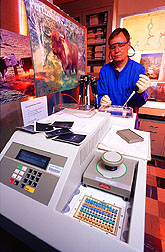Diagnostic Test for Cattle Tuberculosis
A new test that detects cattle tuberculosis bacteria within 3 days is a major improvement over current methods that can take up to 3 months.
Mycobacterium bovis--the culprit in cattle tuberculosis--is similar to two other bacteria, M. avium and M. paratuberculosis. The inability to distinguish among the three has been a problem in eliminating the disease.
The new test, developed by ARS veterinarian Janice M. Miller at the National Animal Disease Center (NADC) in Ames, Iowa, allows researchers to quickly tell which organism has infected an animal. Miller developed the test at the request of USDA's Animal and Plant Health Inspection Service (APHIS). That agency needed the test to aid in joint efforts with state animal inspection agencies and U.S. livestock producers to eradicate cattle TB.
The test uses polymerase chain reaction (PCR), a technique that makes many copies of certain genetic material found only in M. bovis. Making so many copies of the targeted DNA allows easy identification of M. bovis, which couldn't be seen before PCR amplification. Extensive tests in other laboratories have proven that this piece of DNA isn't present in M. avium or M. paratuberculosis. Researchers recently developed new tests using the same technology to identify both of these organisms.
Miller and others at NADC and at APHIS' National Veterinary Services Laboratory in Ames validated the PCR test by examining 99 known cases of TB in cattle and elk. In 93 percent of the cases, they could make an accurate diagnosis within 2 to 3 days after receiving the tissue samples.
The speedier diagnosis will allow APHIS officials to take immediate action to identify the most common sources of cattle tuberculosis: imported Mexican steers, the captive elk and deer population, and large dairy herds with low levels of infection.
TB spreads when coughing releases the bacteria into the air. Although human tuberculosis in the United States is ususally caused by a different bacterium--M. tuberculosis--the M. bovis organism can cause TB in humans, and M. tuberculosis can cause TB in livestock and other animals.
Humans don't get TB from eating meat or drinking milk from infected animals because pasteurization and appropriate cooking temperatures kill the disease organism. When milk pasteurization standards were developed in the 1920s, M. bovis and M. tuberculosis were considered the most resistant pathogens then known.--By Linda Cooke McGraw, Agricultural Research Service Information Staff.
Janice M. Miller is in the USDA-ARS Respiratory and Neurologic Diseases Research Unit, National Animal Disease Center, P.O. Box 70, Ames, IA 50010; phone (515) 239-8349, fax 239-8458.
"Diagnostic Test for Cattle Tuberculosis" was published in the September 1998 issue of Agricultural Research magazine. Click here to see this issue's table of contents.







